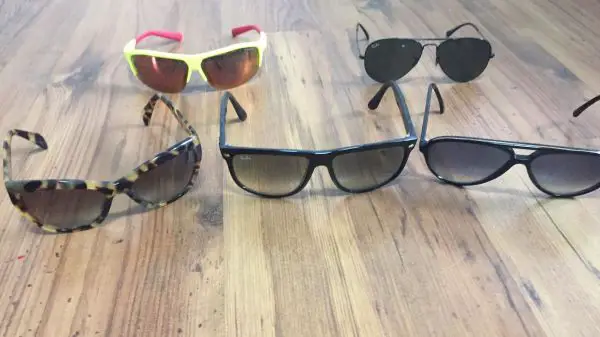Polarized Sunglasses are an essential piece of kit when flyfishing. They are nearly as important when spinning for trout. I never head to my local river or stream without a pair of polarized glasses.
So, what are the best sunglasses for trout fishing? Will, I have spent over 15 years sight fishing the mountain streams of New Zealand, in all weather conditions. Over that time, I have learned that not all sunglasses are created equal, and the right pair of glasses can easily make or break a day on the river.
I need to jump straight to the point. There is no one best brand or model of sunglasses. There are countless variations from dozens of brands. As long as they are polarized most of them, except the cheapest of the cheap work just fine.
Some people ask is there any advantages to non-polarized glasses? There are a couple of niche cases where non-polarized glasses have an advantage. The first is winter fishing, polarized glasses can make it more difficult to recognize patches of ice because they filter out the reflective glare. So, this in theory could lead to more slips and tumbles.
The second disadvantage is that polarized glasses can make it more difficult to read some digital displays. If you are having difficulty seeing fish finder displays, then non-polarized glasses could help.
What are the best color Sunglasses for trout fishing?
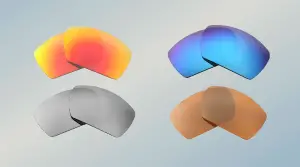
- Amber/Copper: If you are buying one pair of sunglasses just for trout fishing then amber or copper is the best general purpose lens color. Amber lenses do an excellent job at enhancing contrast making it easier to identify trout between the rocks.
- Yellow: Very similar to amber but brighter, yellow lenses allow more light in making them slightly better in low light or overcast conditions.
- Green: I have never worn green lenses, but apparently they are also very good for dull low light conditions. This is because our eyes are most sensitive to the color green, so green lenses make everything really stand out.
- Gray / blue: Best color for very bright and sunny conditions. If the light is simply too bright then grey lenses are the best at dulling the light. They are a good option for boat fishing in open water.
- Clear: These are more safety glasses than sunglasses, consider wearing clear glasses when fly fishing at night. If you are anything like me, your casting will deteriorate when you can not easily see your line making eye protection even more important.
The 8 Best Sunglasses for trout fishing.
There are a lot of sunglass brands and models on the market, too many to test them all. Over the last decade, I have probably worn 30 pairs. I am rough on them and lose more than I care to admit.
So based on my own personal experience, and research here is what I consider to be the best performing sunglasses for trout fishing.
Smith Optics Guides Choice – Best Glass Lens Fishing Glasses
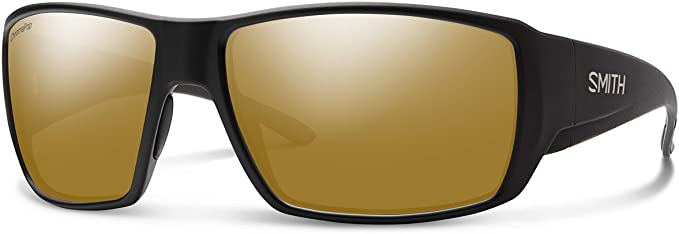
When it comes to premium sunglasses for fishing. I find it very hard to beat the Smiths Guide Choice. They are built extremely well and are priced competitively with other premium glasses.
- Wide glass lenses do an excellent job at blocking light.
- Lens width: 62mm
- Lens height: 42mm
- Excellent Lens clarity I could not pick up any distortion.
- Their bronze lens is very well suited for trout fishing.
- Thick and solid frame, designed to block the maximum amount of light from sneaking in from the sides and behind.
- Integrated connection point for a lanyard.
- Bifocal options are available.
I owned a pair for years, and despite treating them roughly I never managed to scratch the glass lens. I eventually lost them while filming a flood, only to rediscover them two years later. One lens was missing, the other was milky from micro scratches but quite surprisingly the frame was still intact. They are built to last.
While the glasses were a write-off, I was still highly impressed with how well they held up.
I have also heard nothing but good things regarding their customer support and overall warranty process.
Costa Del Mar Men’s Blackfin Pro
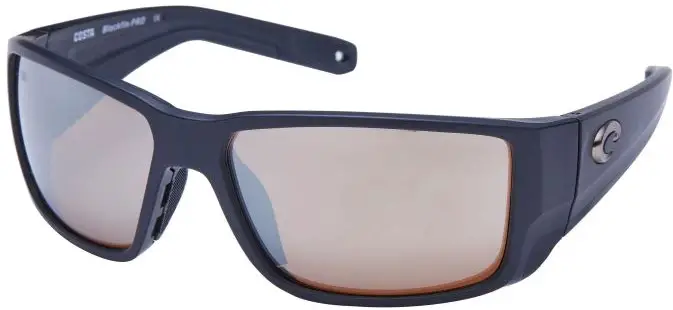
Honestly, there is not much that separates the Blackfin Pros from the other sunglasses on this list. It is another great option, and due to the build quality and clairty they have a lot of fans among fishermen. I want to say more but there is only so much which can be written about sunglasses without stating the obvious.
The Blackfin pro is a traditional sunglass style for fly fishing. The large oval lenses provide excellent protection against the sun and any wayward fly. They have a very wide frame to prevent light from getting in from the sides.
- Wide lens, a touch smaller than the Guide Pro.
- Lens width: 60mm
- Lens height: 41mm
- Wide frame to block light intrusion from behind.
- Comes in both polycarbonate and glass lens versions.
- Glass Lens has excellent clarity and distortion free.
- I particularly liked the yellow lens for fishing in the evenings.
- Integrated lanyard connection point.
- Assembled in USA
You can tell the difference by looking at the model number. The polycarbonate version ends in a P and the glass version ends in a G.
They also come with a pretty decent warranty.
Oakley Split Shot – Best Lightweight Fishing Sunglass
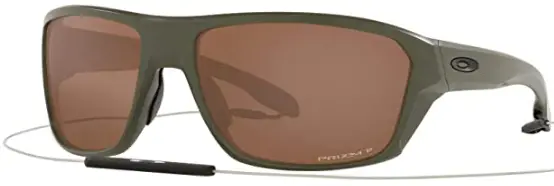
The split shots by Oakley are quite expensive for polycarbonate lenses. But there is probably no better polycarbonate lens on the market.
The lenses are larger than the ones found on both the Black Fin Pro and Guide Choice. Although, I do not notice much of a difference when actually wearing them.
They seem to be extremely well made, although have not had them long enough to know firsthand how they stand up to years of abuse. I do not care how many special coatings they have, being polycarbonate, the lenses will scratch easier than glass.
- Wide Polycarbonate lens.
- Lens Width 64mm,
- Lens Height 43.5mm
- Extremely impact resistant
- The frame is slightly thinner.
- Much lighter than glass lens glasses.
- Excellent clarity and low distortion.
- Excellent selection of lens colors
- An integrated lanyard connection point
- Comes with a coated steel leash.
- Expensive for polycarbonate
- Assembled in USA
Bnus – Best Value Glass Lens

These are the cheapest glass lens polarized sunglasses I could find.
I was a bit skeptical when I first saw sunglass lenses at this price point. Was it really possible to sell an Italian made sunglass, with a glass lens for a third the price of the big names? I had to get a pair to test.
Well, they seem to be very good glasses. The clarity is excellent with very little distortion. The frames seem sturdy and well constructed. I will update this review after I get a season of use out of them.
I purchased the brown lens version, and it has good contrast. I have heard reports that the blue mirror version also has a brown base.
The lenses are nice and broad, offering a good amount of coverage (63mm by 45mm), They weigh 44g / 1.5oz which is fairly typical for a glass lens.
I am impressed and I happily wear them fishing.
Rheos Nautical – (Sunglasses that float!)
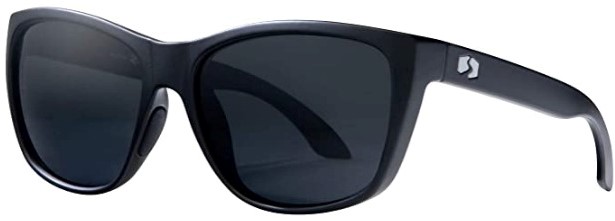
This brand grabbed my attention for three reasons. Firstly they float, Secondly, they only cost $50 and finally they use nylon lenses.
Nylon is not a cheap alternative to polycarbonate but is a new technology being used in lens technology. It offers better clarity (Higher ABBE value) than polycarbonate while offering more impact resistance than glass. It is also very lightweight.
The lens color selection is slightly limited but there is something to suit most conditions. Another slight downside is that the frame is quite narrow, so only blocks a limited amount of sidewise glare.
Nylon is about 20% lighter than polycarbonate and has superior optical clarity. Downsides include slightly reduced impact resistance and higher manufacturing cost, although that is not really reflected in the retail price seen here.
Suncloud – (Big brand quality at budget price?)
Suncloud, the budget brand of Smith deserves a mention.
They are simply a pair of well made polycarbonate sunglass. They do not bring anything special, or unusual just a basic, polarized sunglass. For the money, they are tough to beat.
Sure, you lose the excellent warranty support but for around $50 they are excellent value for money.
Specialized Glasses for Most Niche Fishing Situations
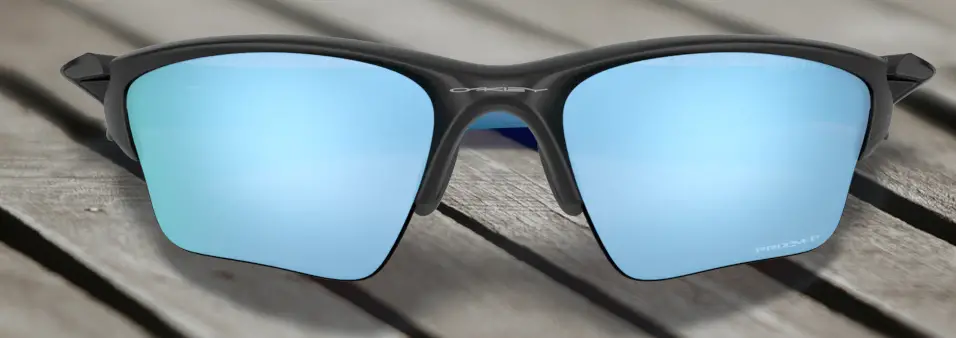
Oakley Half Jacket® 2.0 XL
I like the styling of half jackets, or the very comparale Oakely Flak 2.0 XL. This design is my personal choice when fishing from a kayak or drift boat. The half frame design allows for plenty of airflow that reduces the chance of condensation developing. The XL size lenses also, provides a good amount of coverage.
There is one major drawback, is that the lack of frame does allow in some stray light and glare. If where, or how you are fishing condensation is not an issue, then a fuller more full frame pair of glasses will likely work better..
One nice feature of the Half Jacket 2.0 is its interchangeable lenses. If one lens gets scratched or lost, it is quite easy to order a replacement. Some third-party providers have also started to make nylon lenses compatible with half jackets.
It is even possible to switch out the lenses while on the water. Maybe fish a grey tinted lens during the brightest time of day and switch to a yellow lens for the evening hatch. There is even a clear lens option for night fishing.
I also need to mention, that not all of the lens options are polarized. Double check before buying.
If I do have one complaint, is that Oakley does not currently offer a bronze or yellow lens option for the Half Jacket, but they do for the Flak 2.0 Xl.
If Oakely are not a good fit then Smiths make the Parallel MAX 2 which is a similar design.
Maui Jim Ho’okipa Reader – Excellent bifocal glasses
Tying on tiny flies can be challenging, even more so once your eyesight starts to fail.
These sunglasses are bifocal, making them an excellent choice for fly fishermen whose vision is not quite as good as it once was. (They are also available in standard focal)
Now, there are plenty of bifocal fishing glasses. What makes these special? Well, the lens is exceptionally high quality, with excellent clarity and some of the lowest distortions I have seen in polycarbonate lenses. I really do not know how Maui Jim does it.
The frameless design is a bit of a two-edge sword, it does help prevent the build up of condensation which can at times be problematic, but at the same time, they are structurally weaker and will allow in more reflective glare.
They come with an excellent warranty and customer support. It is usably possible to purchase replacement lenses and parts that can greatly prolong the life of your glasses.
Sources:
The Whip-Like Physics of Fly Fishing | Discover Magazine
Alfaro, D. V., Jablon, E. P., Rodriguez Fontal, M., Villalba, S. J., Morris, R. E., Grossman, M., & Roig-Melo, E. (2005). Fishing-related ocular trauma. American Journal of Ophthalmology, 139(3), 488–492. doi:10.1016/j.ajo.2004.10.011

